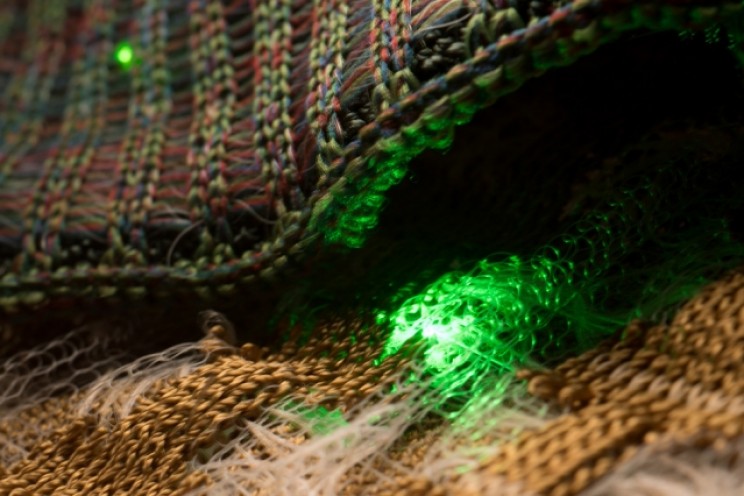MIT Creates Clothes That Talk to Each Other Using Light Pulses

Textile wearables consistently seem to hit a snag. The technology woven into them never seems to be flexible enough for their comfortable use. Now, MIT engineers have created a cloth that seamlessly weaves electronic devices into its fabric.
These engineers embedded high-speed optoelectronic semiconductive devices into the cloth’s fibers. These devices included LEDs and diode photodetectors, giving the cloth a sort of light communication system.
The project was led by MIT grad student Michael Rein and his research advisor/professor of materials science and electrical engineering at the university Yoel Fink. Rein hopes the innovation could spur what he calls a “Moore’s Law” of wearable technology.
Moore’s Law has been the ‘golden standard’ in electronics and is named after Intel co-founder Gordon Moore who predicted massive industry changes for microchips. Rein and Fink hope their discovery could do the same for the emerging wearables industry.
Stretching optic fibers for everyday clothing
Optic fibers are normally made by making a preform, or a cylindrical object, that’s a larger model of the fiber and heating it. The material is then drawn under tension and the fibers get collected in a spool.
In this project, the fibers needed to include preform light-emitting semiconductor diodes the size of a grain of sand in addition to copper wiring the width of human hair. The polymer preform liquified slightly which formed a long fiber that aligned the diodes along the center and connected it via the copper wiring.
As Rein described it, “both the devices and the wires maintain their dimensions while everything shrinks around them,” thus allowing the fibers to be woven into fabrics with ease. The researchers even washed the diode-embedded cloth 10 times to demonstrate just how practical it could be in regular clothing.
“This approach adds a new insight into the process of making fibers,” said Rein who served as the paper’s lead author and developed the concept that led to the new process. “Instead of drawing the material all together in a liquid state, we mixed in devices in particulate form, together with thin metal wires.”
Waterproof wearable technology
One of the biggest advantages to this new infusion of wearables is that it makes the fibers essentially waterproof. The researchers even tested the cloth and fibers within a fish tank.
A lamp outside of the tank played music through the water to the fibers in the form of quick optical signals. The fibers in the tank then converted those rapid light pulses into electrical signals and back into music.
The fibers communicated with each other despite the cloth being submerged in the water for weeks. “This paper describes a scalable path for incorporating semiconductor devices into fibers. We are anticipating the emergence of a ‘Moore’s law’ analog in fibers in the years ahead,” Fink said.
“It is already allowing us to expand the fundamental capabilities of fabrics to encompass communications, lighting, physiological monitoring, and more. In the years ahead fabrics will deliver value-added services and will no longer just be selected for aesthetics and comfort,” he added.
Really? Are you leaving this post without leaving your comment? Review it!
Source: Interesting Engineering
